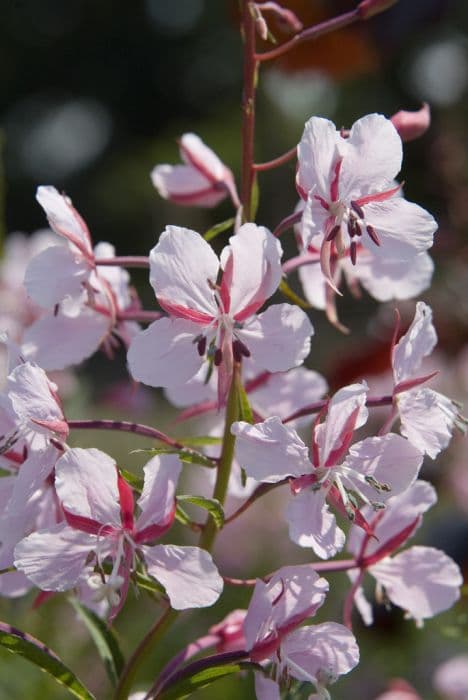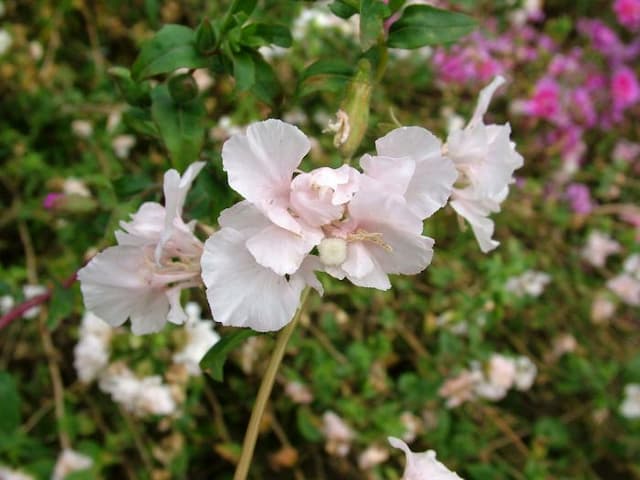Pink evening primrose Oenothera speciosa 'Siskiyou'

ABOUT
The Oenothera speciosa 'Siskiyou', commonly known as the Pink Evening Primrose or Showy Evening Primrose, is a flowering perennial that boasts a lush spread of foliage and vibrant blooms. Its leaves are narrow and lance-shaped, with a soft green hue that creates a delicate backdrop for the flowers. The blooms themselves are the main attraction, notable for their delicate pale pink to white petals that often display a gradient of color, with darker shades at the base that fade to lighter tones at the edges. Each flower features a prominent cross-shape, typical of the genus, with four broad petals that open outwards. The Pink Evening Primrose’s flowers have a satiny texture and a soft, inviting appearance. These blossoms are typically cup-shaped and open in the evening, hence the name 'Evening Primrose'. They release a gentle and pleasing fragrance that becomes more pronounced as daylight fades. Although I am restricted from mentioning the specific size of the plant, the Pink Evening Primrose forms a substantial spread that bursts into a profusion of blooms, creating an attractive ground cover or border plant that can add a touch of wildflower meadow to a garden setting. The flowering period extends through spring and summer, offering an enduring display of color and beauty.
About this plant
 Names
NamesFamily
Onagraceae.
Synonyms
Pinkladies, Pink Evening Primrose, Showy Evening Primrose, Pink Buttercups, Mexican Primrose, Amapola.
Common names
Oenothera speciosa.
 Toxicity
ToxicityTo humans
The plant commonly known as Pink Evening Primrose is not known to be toxic to humans. There are no well-documented cases of poisoning from ingesting parts of this plant, and it generally does not cause harm when touched or consumed in moderate amounts.
To pets
Similar to its effects on humans, the Pink Evening Primrose is not known to be toxic to pets. It is not typically associated with poisoning in animals such as dogs and cats, and ingestion usually does not lead to adverse symptoms. However, as with any non-food plant, the consumption of large amounts could potentially cause mild gastrointestinal upset in some pets due to the novelty and fiber content.
 Characteristics
CharacteristicsLife cycle
Perennials
Foliage type
Deciduous
Color of leaves
Green
Flower color
Pink
Height
1 foot [30 cm]
Spread
2 feet [60 cm]
Plant type
Herb
Hardiness zones
6
Native area
North America
Benefits
 General Benefits
General Benefits- Attracts pollinators: Oenothera speciosa 'Siskiyou', commonly known as Pink Evening Primrose, attracts bees, butterflies, and other beneficial insects, supporting local ecosystems.
- Drought-resistant: Once established, it's well-adapted to dry conditions, reducing the need for frequent watering.
- Low maintenance: This plant requires minimal care, making it suitable for gardeners of all skill levels.
- Fast growth: This plant can quickly establish itself and cover ground, making it a good choice for erosion control.
- Aesthetic appeal: Its pink flowers and foliage add color and beauty to gardens, enhancing visual interest.
 Medical Properties
Medical PropertiesThis plant is not used for medical purposes.
 Air-purifying Qualities
Air-purifying QualitiesThis plant is not specifically known for air purifying qualities.
 Other Uses
Other Uses- Photography: The Siskiyou evening primrose, with its vibrant pink blooms, attracts photographers looking to add natural beauty to their portfolios.
- Artistic inspiration: Artists may use the striking appearance of the evening primrose as a subject for paintings, drawings, or other forms of visual art.
- Education: Botany students can study the Siskiyou evening primrose to understand plant morphology, adaptation, and reproductive strategies.
- Natural dye: The petals of the evening primrose can be used to create a natural dye for fabrics, yielding subtle colors.
- Perfumery: Although not a common use, the Siskiyou evening primrose's delicate scent could potentially be used in perfumes or scented candles.
- Erosion control: The plant’s sprawling habit and root system can help stabilize soil and prevent erosion on slopes.
- Gourmet food decoration: The petals of the evening primrose are edible and can be used as a colorful garnish in high-end culinary creations.
- Landscape design: Siskiyou evening primrose can be used in xeriscaping, requiring less water and maintenance than traditional landscaping plants.
- Wildlife habitat: This plant can provide shelter and food for small wildlife, including insects and birds.
- Crafts: Dried flowers of the evening primrose can be used in crafting, such as in potpourri or pressed flower art.
Interesting Facts
 Feng Shui
Feng ShuiThe Pink Evening Primrose is not used in Feng Shui practice.
 Zodiac Sign Compitability
Zodiac Sign CompitabilityThe Pink Evening Primrose is not used in astrology practice.
 Plant Symbolism
Plant Symbolism- Peace and Serenity: The Oenothera speciosa 'Siskiyou', commonly known as the Pink Evening Primrose, offers a calming presence with its soft pink blooms that open in the evening, suggesting relaxation and peace after a long day.
- Youthful Innocence: Pink flowers, including the Pink Evening Primrose, are often associated with the innocence and playfulness of youth, embodying a gentle spirit and the purity of a young heart.
- New Beginnings: The plant's habit of opening its flowers with the setting sun symbolizes the start of new phases or experiences, akin to the start of the nocturnal hours, indicating rebirth or the start of something fresh.
- Healing: Traditionally used for medicinal purposes, the Pink Evening Primrose is viewed as a symbol of healing and nurturing, offering solace and recovery.
 Water
WaterPink evening primrose needs regular watering, especially during the first growing season to establish a deep, extensive root system. Once established, reduce frequency, except during extreme drought. Provide a deep watering every other week, ensuring soil is moist but not soggy. Generally, aim for about one inch of water every week during active growth periods, which equates to roughly 0.6 gallons per square foot per month.
 Light
LightPink evening primrose thrives in full sun exposure, which means it prefers a spot that receives at least 6 to 8 hours of direct sunlight daily. It can tolerate partial shade, but flowering will be reduced. It is best to plant it in a location where it can enjoy unfiltered sunlight throughout most of the day.
 Temperature
TemperaturePink evening primrose is tolerant of a wide range of temperatures, but it performs best in moderate to warm conditions between 60°F and 90°F. It can survive minimum temperatures down to about 20°F, but freezing temperatures can damage the plant. Its optimal growing conditions include warm days and cooler nights.
 Pruning
PruningPink evening primrose benefits from occasional pruning to stimulate new growth and encourage more blooms. Prune back spent flowers and dead stems after the blooming period to maintain plant health and appearance. Pruning can be done once a year, usually in the late fall or early spring before new growth starts.
 Cleaning
CleaningAs needed
 Soil
SoilThe Pink Evening Primrose prefers a well-draining soil mixture with loamy or sandy characteristics; a mix of two parts garden soil, one part sand, and one part compost is ideal. The soil pH should be neutral to slightly acidic, around 5.5 to 7.
 Repotting
RepottingPink Evening Primrose does not typically need frequent repotting as it is a perennial plant. Repotting every two to three years or when root-bound is sufficient to maintain its health.
 Humidity & Misting
Humidity & MistingPink Evening Primrose is tolerant of various humidity levels and does well in the average outdoor humidity; it does not require any specific humidity adjustments.
 Suitable locations
Suitable locationsIndoor
Place in bright, indirect light and keep the soil lightly moist.
Outdoor
Full sun, well-draining soil, water when top inch is dry.
Hardiness zone
5-9 USDA
 Life cycle
Life cyclePink evening primrose (Oenothera speciosa 'Siskiyou') is a perennial plant that starts its life cycle as a seed, which, under appropriate conditions of warmth and moisture, germinates in the soil. The seedling emerges and develops true leaves, growing into a juvenile plant. Over time, it matures into an adult plant with a robust root system and foliage. During the flowering stage, typically in spring or early summer, it produces showy pink flowers that open in the evening and close by midday. After pollination, usually by moths or bees, the flowers develop into fruit capsules containing numerous seeds. Once these seeds are mature, they are dispersed by wind or animals, completing the cycle when they germinate and grow into new plants.
 Propogation
PropogationPropogation time
Spring to Summer
Propogation: The Pinkladies or Pink Evening Primrose, Oenothera speciosa 'Siskiyou', is commonly propagated by seed. The ideal time for sowing seeds is in the fall, as Pinkladies require a period of cold stratification to germinate successfully. After the seeds have undergone cold stratification, they may be sowed directly into a well-draining soil medium where they will germinate when the temperatures rise in spring. To ensure best results, sow the seeds on the surface of the soil and lightly press them in, as they need light to germinate. Keep the soil moist but not waterlogged. Once the seedlings have developed several true leaves, they can be transplanted into individual pots or directly into the garden where they will continue to grow and eventually flower.









